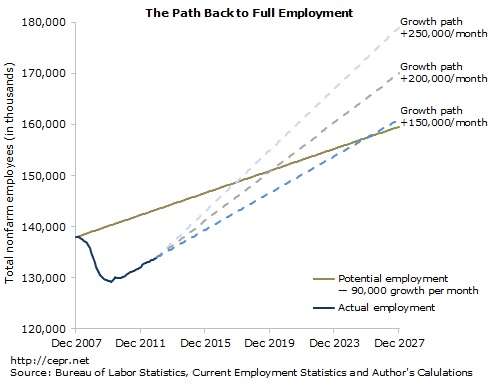January 04, 2013
January 4, 2013 (Jobs Byte)
By Dean Baker
Manufacturing added 25,000 jobs, the strongest growth since April.
The unemployment rate remained at 7.8 percent in December, the same as the revised number for November. The unemployment rate has essentially been unchanged the last four months. Interestingly, while the unemployment rate has fallen by 0.7 percentage points from its year-ago level, the employment-to-population ratio (EPOP) is unchanged at 58.6 percent, just 0.4 percentage points above the low for the downturn. The establishment survey showed the economy adding 155,000 jobs in December. This is virtually identical to the 151,000 average over the last three months and the 154,000 average over the last year.
There was little very new in the demographic distribution of unemployment. White men continue to do somewhat better than white women, with the unemployment rate for white men dipping by 0.2 percentage points to 6.2 percent, putting it marginally below the 6.3 percent rate for women. The unemployment rate for white men had peaked at 9.6 percent in Oct-Nov of 2009 when the unemployment rate for white women was just 7.3 percent. The unemployment rate for African Americans rose by 0.8 percentage points to 14.0 percent, indicating that a 1.3 percentage points drop reported in November was an aberration.
The big job gainers continue to be the over 55 cohort, with employment growth of 32,000 in December, more than the 28,000 overall employment gain for workers 16 and older reported in the household survey. Over the last year, older workers have accounted for 1,777,000 of the 2,409,000 reported gain in employment. The biggest losers have been the 45-54 cohort, who have seen their employment fall by 288,000 over this period. In both cases the gender split has been close to even.
All the duration measures of unemployment fell in December. The median duration of unemployment is now 2.6 weeks below its year-ago level; the mean 2.8 weeks lower; and the share of long-term unemployed is down by 3.7 percentage points. On the other side, the number of discouraged workers is up 123,000 from the year-ago level, the largest increase since December of 2010.
The job growth in the establishment survey continues to show some erratic seasonal patterns. Retail reported a loss of 11,300 jobs after adding a total of 107,000 the prior two months. The decline was driven by a loss of 18,700 jobs in clothing. This reflects earlier hiring for the holiday shopping season. Jobs for couriers fell by 10,800 in December, a decline that will almost surely be reversed.
Manufacturing added 25,000 in December, the largest increase since a 42,000 rise reported in March. The rise in jobs was also accompanied by a small increase in the length of the average work week from 40.6 to 40.7 hours. Interestingly, the non-durable sector accounted for most of the rise, adding 14,000 jobs. While most of this gain was just offsetting a 13,000 decline reported in November, there was 0.2 hour increase in the length of the work week in the non-durable sector, raising it to 40.3 hours compared with 40.0 in October.
Construction added 30,000 jobs in December. This sector has been an anomaly, with employment up by just 20,000 year-over-year in spite of large gains in both residential and non-residential construction. The information sector shed 9,000 jobs, largely reversing an increase of 13,000 jobs in November. Employment in the temp sector was essentially flat in December, providing little evidence of any pent-up demand awaiting the resolution of the “fiscal cliff” debate.
Health care added 44,500 jobs, which is likely just offsetting the relatively weak 19,700 jobs reported for November. Restaurants added 38,000 jobs in December, considerably more than the 24,000 average over the last year.
Government employment fell by 13,000, almost entirely the result of a drop of 11,500 jobs in local government education. Over the last year jobs in local government education have been down by 54,000, but this is almost exactly offset by an increase of 53,000 jobs in state government education.
There is little in this report to suggest any divergence from the modest growth path that the economy has been following the last two years. The 155,000 pace of job growth is consistent with a declining unemployment rate, but will not return us to full employment until the next decade.







